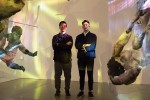This post was updated Oct. 2 at 4:25 p.m.
The geopolitics behind President Donald Trump’s Twitter beef with Kim Jong Un is among several subjects that are the focus of artworks in the “We, Activeast” show.
The event, which opened Thursday, is organized by graduate students of the UCLA Department of Art as a part of the New Wight Biennial. The biennial alternates between a focus on local artists and international artists. “We, Activeast,” this year’s internationally-focused New Wight Biennial, combines various art forms, such as sculptures, photographs and video projections in an attempt to address social and geopolitical issues, specifically in East Asian countries, said Jinseok Choi, one of the artists featured in the show.
“The group show wants to show how Asian artists navigate themselves, … how they navigate this world, especially with the things that are happening,” Choi said.
East Asian countries are affected by each other as well as by Western countries, Choi said. For example, Korea is impacted by the presidency in the United States. After Trump’s election, Choi said there were Twitter disputes between Kim and Trump, leading South Korean news media outlets to address the possibility of war and the Korean population to panic. Jae Hwan Lim, a graduate student and the co-curator, said he hopes to foster increased universalism with the exhibition, bringing about a common understanding between Asian countries about each nation’s social and political issues.
“The younger generations, the current American populations or any other Koreans living outside of the Korean Peninsula are always conscious of that division and how sad that situation is and how impactful that is to the future generations as well,” Lim said. “Both South and North Koreans are always frustrated at the possibility of war.”
The exhibition will serve as a forum for discussion about equality as well as the oppression taking place throughout various countries, said Hailey Loman, the other co-curator and graduate student. The art pieces are divided into three categories for the exhibition, Lim said: body and gender, history and sociopolitics, and technology and environment.
One artwork in the body and gender category is a collection of life-sized sculptures of female bodies dispersed in different areas of the exhibition, Lim said. Monica On Yau Tai, the piece’s artist, invited 26 female volunteers and modeled their bodies, excluding their heads. Lim said Tai wanted to convey how Hong Kongese females and their bodies are considered in their society, specifically how external appearance is praised over internal qualities. The scattering of figures all around the show allows visitors to weave through them and thereby mimics how the attitude toward women has become a regular idea in Hong Kongese society, Lim said.
Another artist, Hannah Kim Varamini, created a collection based on Neolttwigi, an outdoor game in Korean culture. The collection of seesaw-like constructions, which are used in the Neolttwigi, aims to emphasize the needed balance between North and South Korea, Lim said. Choi said one of Varamini’s seesaws has the North Korean national flower on one side and the South Korean national flower on the other. Neolttwigi only works if people are jumping on each side – Lim said Varamini embraces the importance of overlap between the two Korean countries.
“A lot of Korean people, younger generations especially, are not aware and didn’t experience the war tragedy,” Lim said. “It’s very special that Korean-American artists like (Varamini are) dealing with that issue, are trying to bring that awareness to this American institution and share with people who didn’t know about that culture.”
Mitsuko Nakagawa, a featured Japanese artist, said her piece entitled “6 figures” is composed of six separate panels and two projectors. The abstract art will shine on six panels made from fabric to create multiple visual layers, showing Japanese people unable to express their struggles after the Tohoku earthquake and the nuclear power plant meltdown at Fukushima. Nakagawa said she hopes to raise awareness about the devastation that followed the meltdown.
Choi’s work, a lecture-style presentation with a powerpoint that is featured only on the exhibition’s opening night, is divided into two parts. Choi said he will begin by discussing Korean cultures and historical events, including Korean hip-hop, Japan’s colonization of the country and the Korean war. He said he will then diverge into his own experiences as a child. Choi struggled with being an artist in a Western-dominated world, and began to realize the complicated relationships between Japan and Korea after piquing an interest in Japanese culture.
Art students are often exposed to white, male-dominated art histories no matter the country of residence, Choi said, which complicated his learning experience. Despite learning English and Western art history, Choi said he found that there were additional struggles he faced as an Asian artist navigating his way through a Western-dominated world, such as adapting to different cultures and realizing the conflicts between countries.
With the exhibition, Choi said he hopes viewers understand his perspective and realize that some artists have an additional layer of cultural struggles to combat. Loman said it is important to have a stage for less-acknowledged issues to be presented to a Los Angeles audience by merging art and activism.
“We are hoping that (“We, Activeast”) generates conversation and that there is some sort of universalism that happens, so that it becomes more global issues,” Loman said. “Rather than bound by (borders like) South Korea or China, that things start to become entered into global discussions.”
